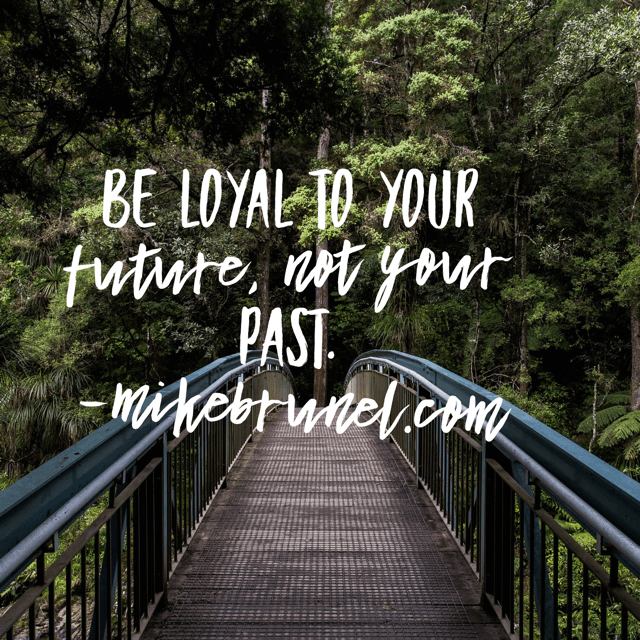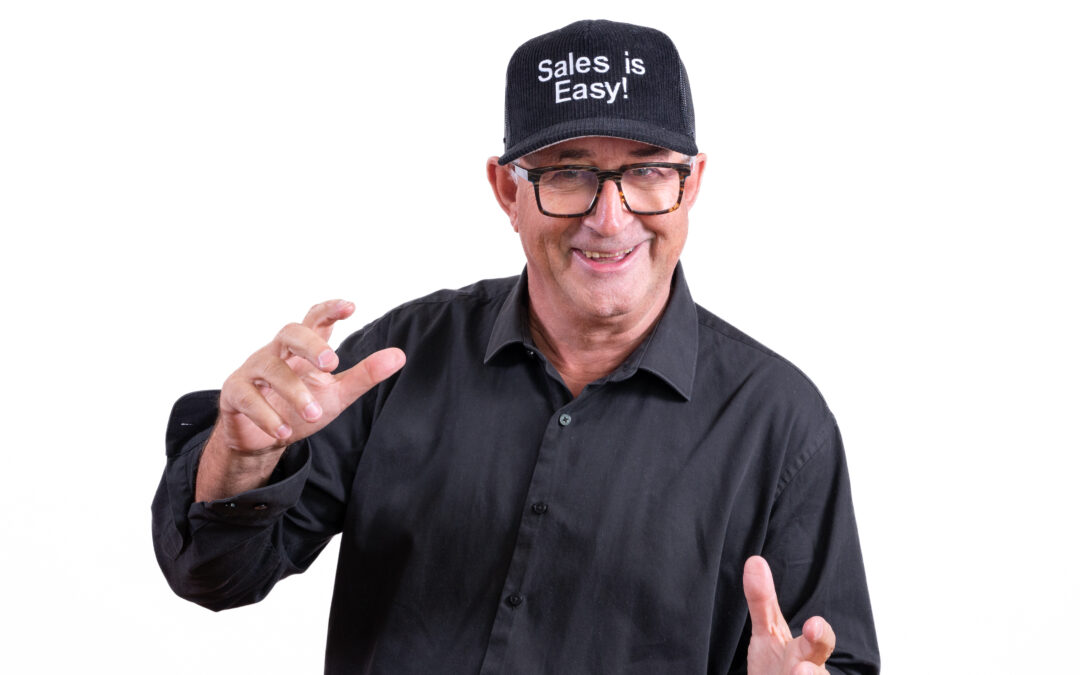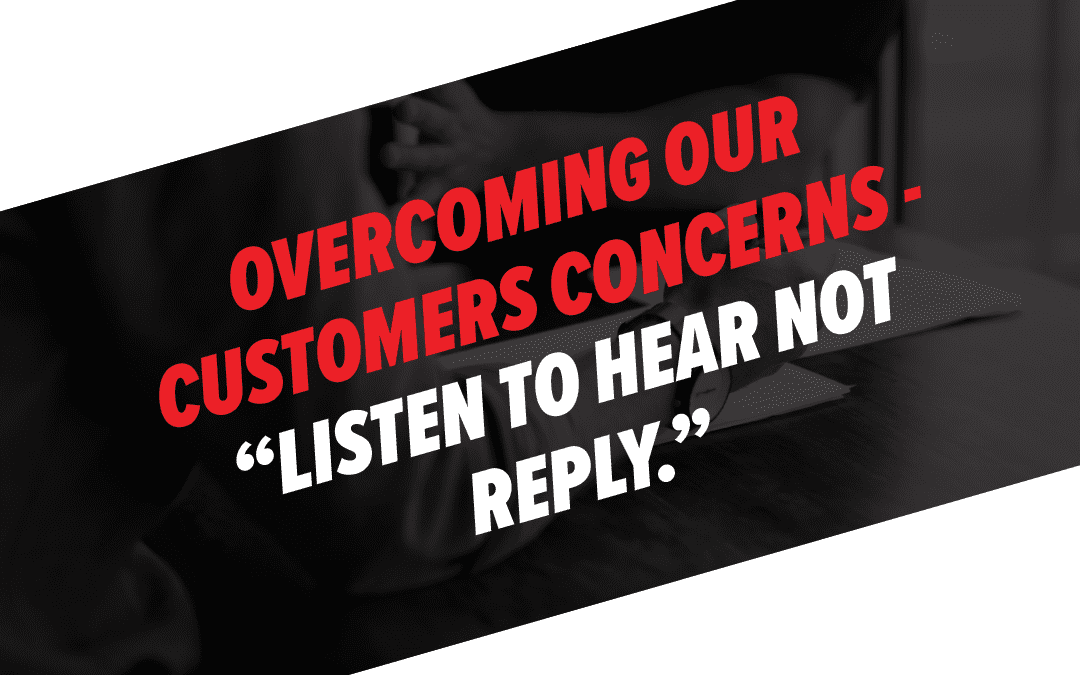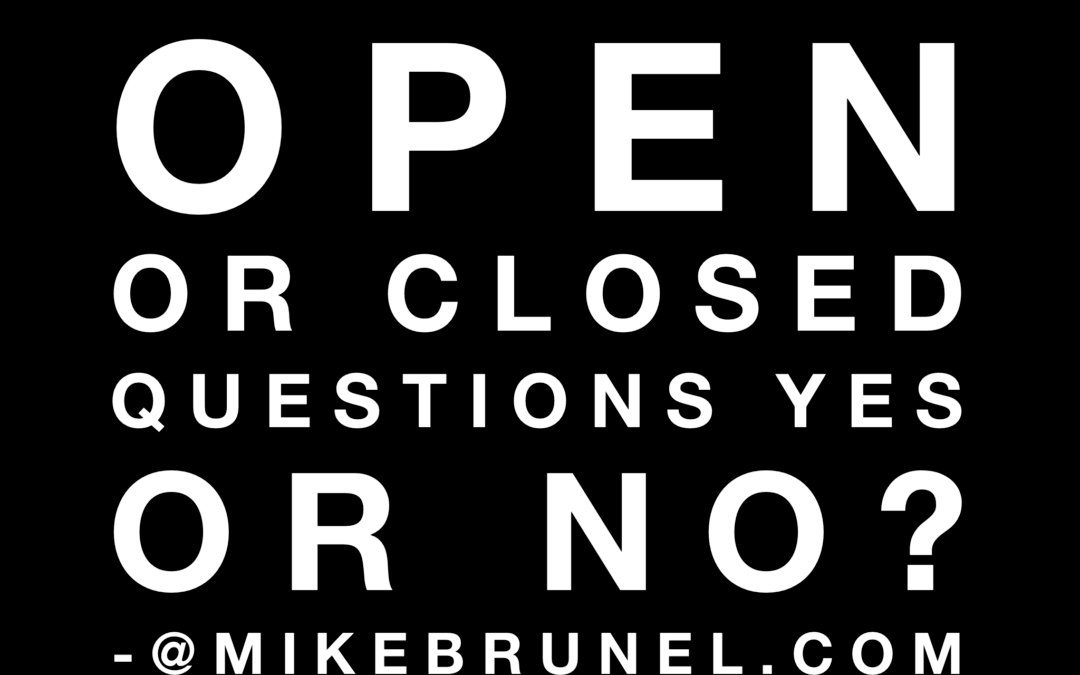by Mike Brunel | Mar 13, 2024 | Sales
Several years ago, when attending one of Robert Kiyosaki’s courses, he told the group the story of the Black Door.
It was about a young man and a Persian general.
The young man, it is said, was a prisoner of war, and the general was a very fair man. When the day arrived to decide the prisoner’s fate, the general brought the prisoner before him.
The young man was certain of death, but the general generously gave him two choices.
On the young man’s left was a firing squad, guns poised ready.
On the right was a plain white wall with a large black door in the middle.
The young man was given a few moments to determine his fate…the firing squad or the black door.
The young man made his choice, and in a short while, a volley of shots rang out, and the prisoner crumpled to the ground.
The general shook his head and commented to his aide that in all his years, he had seen only a few men choose the black door.
“May I ask, sir,” the aide queried- “what lies beyond the black door?” “Freedom.” The general replied.
“The black door leads to freedom, but I have seen only a few men choose it because they fear what horrors may lie beyond.
Most would rather choose a fate that they know, even if it means death than experience the unknown. The man brave enough to choose the black door deserves freedom.”
Today, in the world of sales, we know that change is always upon us.
The sad thing is that many salespeople would rather stick with what they know than what they don’t know.
We experience change in our lives every day; it’s a part of life.
Sales is no different; there will always be an underlying principle to selling, but there is also the unknown.
What does that look like? – It comes in many forms: the approach to selling, discovering, and understanding your client’s needs.
These are often driven by them, not you.
The most successful salespeople I know are constantly learning and loading up on new information.
Dan Sullivan, at Strategic Coach, has a great saying. “Our eyes only see, and our ears only hear what our brain is looking for.”
Are you ready to choose The Black Door?
Dedicated to your sales Success.
Mike
PLUS, whenever you are ready…here are 3 ways I can help you grow YOUR business.
1. Grab a Free copy of my book
It’s the sales roadmap to attracting prospects, building, and making more sales in your business without coming across as salesy- Click Here.
2. Join the Sales Mindset Inner Circle and connect with salespeople like you.
It’s our new Facebook community where salespeople learn to get more income, enhance their ability, and get access to exclusive content- Click Here
3. Join –“Sales Mindset Blueprint: (INVITATION ONLY) Elevating perspectives, boosting confidence, driving results and not coming across as salesy. Reply to SALESY, and I will get you the details.

by Mike Brunel | Nov 28, 2023 | Motivation and Mindfulness, Sales
“Year-End Goal Reflection and Planning”
As we approach the end of the year, it’s a crucial time to reflect on the progress we’ve made and set our sights on 2024.
During the holiday season, you might find it beneficial to take a moment and look back at your achievements over the past 12 months.
This period of reflection is not just about celebrating successes but also about understanding the hurdles that stood in our way.
After evaluating the goals you reached, pinpoint the factors behind these successes,
Then take a peak into the future and set some time aside to set new objectives for 2024.
Personally I always make a point to acknowledge and celebrate the goals I’ve accomplished.
This recognition is a vital part of the journey, reinforcing positive behaviors and attitudes.
However, it’s equally important to ask ourselves, “Why did some goals remain unfulfilled?” These goals were significant enough to be set, yet they remained elusive.
This self examination could be the key to understanding and overcoming the barriers to your success.
“What have I learned?
Some goals might have been too ambitious,
Or, I didn’t allot a realistic timeframe to achieve them.
Perhaps I didn’t dedicate the necessary resources, or my emotional commitment wavered. T
he passion and consistent effort I applied to my successful goals might have been lacking in others. Additionally, consistent monitoring and adapting were sometimes missing.
In my upcoming article, I’ll share strategies to overcome these obstacles.
These insights aim to kickstart your 2024 with clarity and a renewed drive to achieve your goals.
Until then, embrace the journey of selling and growing in 2024!
Mike.
PLUS, whenever you are ready…here are ways I can help you grow YOUR business.
1. Join my free Facebook group – Sales Mindset Inner Circle
My favourite thing to do is show you what’s working right now. It’s not as good as being a client, but it’s close.
2. Take advantage of a FREE 45-minute consultation
Need some sales support? it. Please make an appointment, and let me take you through the past, present, and future templates.
Finally, grab my new digital book on ‘How to get a predictable sales system into your business without coming across as salesy’

by Mike Brunel | Nov 20, 2023 | Sales, Strategy
The Salesperson’s Checklist: Honing Your Questioning Skills
Over the last few weeks, we have been talking about all sorts of questions. Sales Questions, personal questions, goal-setting questions, open questions,
In the dynamic world of sales, the ability to ask the right questions is a game-changer.
As promised from last week’s blog, here’s a practical checklist I compiled from these articles to help you think about having effective conversations and better results.
1. Prepare Your Mindset
- Understand the value of questions in building relationships.
- Shift focus from selling to learning about the client’s needs.
2. Research Your Client
- Gather background information about the client and their business.
- Identify potential challenges they might be facing.
3. Develop Open-Ended Questions
- Create questions that cannot be answered with a simple yes or no.
- Ensure your questions are relevant to the client’s context.
4. Practice Active Listening
- Focus fully on the client’s responses.
- Avoid planning your next question while listening.
- Show that you are listening through nods and affirmations.
5. Follow-Up Questions Are Key
- Develop follow-up questions based on the client’s responses.
- Dig deeper to uncover underlying needs or challenges.
6. Balance the Conversation
- Ensure that the client does more talking than you.
- Guide the conversation without dominating it.
7. Read Non-Verbal Cues
- Pay attention to the client’s body language and tone.
- Adjust your approach based on these cues.
8. Reflect and Learn from Each Interaction
- After each meeting, review what went well and what didn’t.
- Continuously refine your questions based on past experiences.
9. Practice, Practice, Practice
- Regularly role-play sales scenarios with colleagues.
- Seek feedback on your questioning technique.
10. Stay Curious and Empathetic
- Maintain genuine curiosity about your clients’ needs.
- Cultivate empathy to connect with clients on a deeper level.
This checklist is designed to be a living document for sales professionals.
Regularly revisiting and updating your approach to questioning can lead to more meaningful client interactions and successful outcomes. Remember, the right question at the right time can make all the difference.
Good selling this week.
Mike
PLUS, whenever you are ready…here are ways I can help you grow YOUR business.
1. Join my free Facebook group – Sales Mindset Inner Circle
My favourite thing to do is show you what’s working right now. It’s not as good as being a client, but it’s close.
2. Take advantage of a FREE 45-minute consultation
Need some sales support? it. Please make an appointment, and let me take you through the past, present, and future templates.
Finally, grab my new digital book on ‘How to get a predictable sales system into your business without coming across as salesy’

by Mike Brunel | Nov 13, 2023 | Sales
The Power of Open-Ended Questions in Sales
Last week, our blog highlighted the importance of keeping the client engaged by asking the right questions. This week, we delve deeper into the art of using open-ended questions in sales conversations.
Mastering Open-Ended Questions
“Harnessing the Power of Open-Ended Questions.”What exactly are open-ended questions?
These are inquiries that prompt more than just one-word responses. They open the door to detailed answers, lists, clarifications, or expansive information about a client’s needs.
Examples of Open-Ended Sales Questions
How you frame your questions can dramatically alter the course of your sales dialogue. Let’s explore some examples:
- What do you expect from your salesperson?
- Can you elaborate on that?
- How would you describe your ideal product?
- Tell me about your experience purchasing a similar product.
- What are the limitations of your current product?
- Could you specify what features you’re looking for?
- Which colours do you prefer for this product?
- When would be the ideal delivery time for you?
- Why does that particular shade appeal to you?
Each question requires a response beyond a simple ‘yes’ or ‘no’, paving the way for a richer, more informative conversation.
Beyond Yes or No: The Impact of Open-Ended Questions
Open-ended questions do more than elicit lengthy responses; they steer the conversation away from just price haggling, opening avenues to truly understand the client’s problems and how your product or service can offer solutions.
The Art of Listening for Clues
Asking open-ended questions does something else: it allows you to listen for clues. These clues often manifest as problems the client faces, and each problem is an opportunity for you to present a solution.
Looking Ahead: Practice Makes Perfect
Next week, we will delve into practical tips using a simple checklist. Until then, happy selling!
Mike (open-ended-questions) Brunel
PLUS, whenever you are ready…here are ways I can help you grow YOUR business.
1. Join my free Facebook group – Sales Mindset Inner Circle
My favourite thing to do is show you what’s working right now. It’s not as good as being a client, but it’s close.
2. Take advantage of a FREE 45-minute consultation
Need some sales support? it. Please make an appointment, and let me take you through the past, present, and future templates.
Finally, grab my new digital book on ‘How to get a predictable sales system into your business without coming across as salesy’
.
Click the link
by Mike Brunel | Nov 6, 2023 | Negotiation, Sales
The Transformative Power of Effective Sales Questioning Techniques
Over the past fortnight, my blog has emphasised a powerful theme critical for any sales professional’s success: Effective Sales Questioning Techniques.
The ability to ask the right questions can dramatically shape our interactions with clients.
The Misconceptions of Salesmanship
A common misconception in sales is equating the craft with employing underhanded tactics akin to those of a stereotypical slick salesperson.
There is no place for “slick” in today’s sales environment.
This approach is short-sighted. The true art of sales lies in deploying effective sales questioning techniques to delve into what truly occupies a client’s mind.
My own business witnessed a considerable transformation when we shifted our focus from pitching to questioning—our conversations became more engaging, and our sales cycle moved more smoothly.
Keeping the Conversation Alive
How can one maintain a lively and engaging sales dialogue? By implementing effective sales questioning techniques, you foster a conversation that naturally progresses.
The path a sale takes is often shaped by the questions we ask, guiding the conversation toward a fitting resolution.
A mentor of mine, Brian Duffy, always stressed the significance of letting the client do the talking: “If the client is speaking, you’re learning and the sale is advancing. If you’re doing all the talking, progress halts.”
His style of saying “Shut up and listen”
The Art and Science of Effective Questioning
So, how does one perfect their effective sales questioning techniques? In my book, I explore the contrast between ‘Can I help you?’ questions and those that ‘Open up a discussion’—the difference between closed-ended and open-ended questions. Understanding this contrast is key to preventing potential clients from slipping away.
The Pitfalls of Closed-Ended Questions
The issue with closed-ended questions is that they can back a respondent into a simple ‘yes’ or ‘no’ corner.
Examples include.
- Can I help you?
- Is that your final answer?
- Should I call and sort it out?
- Are you interested in our new product?
- Are you satisfied with these options?
- Are you just browsing today?
- Hello there.
- Let me know if you need assistance, alright?
These types of questions, while common, often bring the conversation to a halt.
There are exceptions, but generally, they are not effective sales questioning techniques that uncover the deeper concerns or needs of a customer.
By consistently practising effective sales questioning techniques, salespeople can transform their interactions, better understand their clients, and ultimately, achieve greater success in their sales careers.
Mike (Make your questions be open ones) Brunel
PLUS, whenever you are ready…here are four ways I can help you grow YOUR business.
1. Join my free Facebook group – Sales Mindset Inner Circle
My favourite thing to do is show you what’s working right now. It’s not as good as being a client, but it’s close.
2. Take advantage of a FREE 45-minute consultation
Need some sales support? Make an appointment, and let me take you through the past, present, and future templates.
3. Work with me one-on-one
If you want to take your product or service from face-to-face to virtual selling, then I have a product that may be able to help you. You can get started for as little as $250 a month. If you’re interested then email mike@mikebrunel.com and put ‘Virtual Selling’ in the subject line…tell me a little about your business and I’ll get you all the details.
4. Finally, grab my new digital book on ‘How to get a predictable sales system into your business without coming across as salesy’
Click the link
Cheers
Mike Create PDF

by Mike Brunel | Oct 30, 2023 | Motivation and Mindfulness, Sales
“Transform your sales approach with our unique training, focusing on open-ended questions to boost engagement and close deals effectively
Introduction: Unleashing the Joy of Selling
How can we empower our sales team to embrace the joy of selling? Transforming the sales process into an enjoyable experience starts with cultivating the art of asking open-ended questions.
One effective exercise that we can implement in our training sessions is the “What’s in my Pocket?” activity, introduced to me by Stephen Pead, a cherished colleague and friend at NRS Media.
Understanding Open vs. Closed Questions
Before diving into the exercise, it is crucial to ensure clarity on what differentiates an open question from a closed one. Open questions are invitations for expansive conversations, whereas closed questions typically prompt a short “yes” or “no” response.
The “What’s in My Pocket?” Exercise
In this engaging exercise, the trainer conceals an unconventional object in their pocket, steering clear of predictable items such as keys or a handkerchief. Instead, opt for something slightly more unexpected, like a wedding ring or a bottle top. The goal is to encourage curiosity and thoughtful questioning.
Closed Questions: A Limited Approach
Starting with closed questions, instruct the team to pose ten inquiries, to which you can only respond with “yes” or “no”. Experience shows that this method rarely leads to the correct answer.
Open Questions: Unleashing Potential
Transitioning to the second part of the exercise, invite the participants to ask ten open-ended questions. These inquiries encourage elaboration and provide the salespeople with a greater context, increasing the likelihood of them deducing the hidden object correctly within just a few attempts.
Examples and Impact
For instance, a closed question might be, “Is the object in your pocket something commonly used?”
This query restricts the trainer to a brief and limited response. Conversely, an open-ended question such as, “How does the object in your pocket serve its purpose?” invites a detailed answer, providing valuable insights and leading to a more fruitful discussion.
Embracing Vulnerability and Leadership
The power of open-ended questions cannot be overstated. They have the potential to transform conversations, uncovering needs and desires that might otherwise remain hidden. However, it’s not uncommon for individuals to hesitate, fearing that their questions might expose vulnerability or uncertainty.
Training for Success
Herein lies the challenge and the opportunity for sales professionals: to embrace the role of a thoughtful leader, adept in the art of inquiry. By modelling this behaviour and investing time in training, we can instil confidence in our team and ensure they understand that not every client interaction will result in an immediate sale.
Conclusion: Building Meaningful Connections
Initiating meaningful conversations and establishing rapport are critical steps in aligning with potential customers. This skill set, which hinges on distinguishing between open and closed questions, is a prerequisite that our sales team should master well before engaging with clients.
By fostering an environment that values and encourages open-ended questioning, we pave the way for more meaningful interactions, ultimately enhancing the sales experience for both our team and our customers.
Mike (Make your questions be open ones) Brunel
PLUS, whenever you are ready…here are four ways I can help you grow YOUR business.
1. Join my free Facebook group – Sales Mindset Inner Circle
My favourite thing to do is show you what’s working right now. It’s not as good as being a client, but it’s close.
2. Take advantage of a FREE 45-minute consultation
Need some sales support? Make an appointment, and let me take you through the past, present, and future templates.
3. Work with me one-on-one
If you want to take your product or service from face-to-face to virtual selling, then I have a product that may be able to help you. You can get started for as little as $250 a month. If you’re interested then email mike@mikebrunel.com and put ‘Virtual Selling’ in the subject line…tell me a little about your business and I’ll get you all the details.
4. Finally, grab my new digital book on ‘How to get a predictable sales system into your business without coming across as salesy’
Click the link: https://www.salesblueprintbook.com/book
Cheers
Mike




